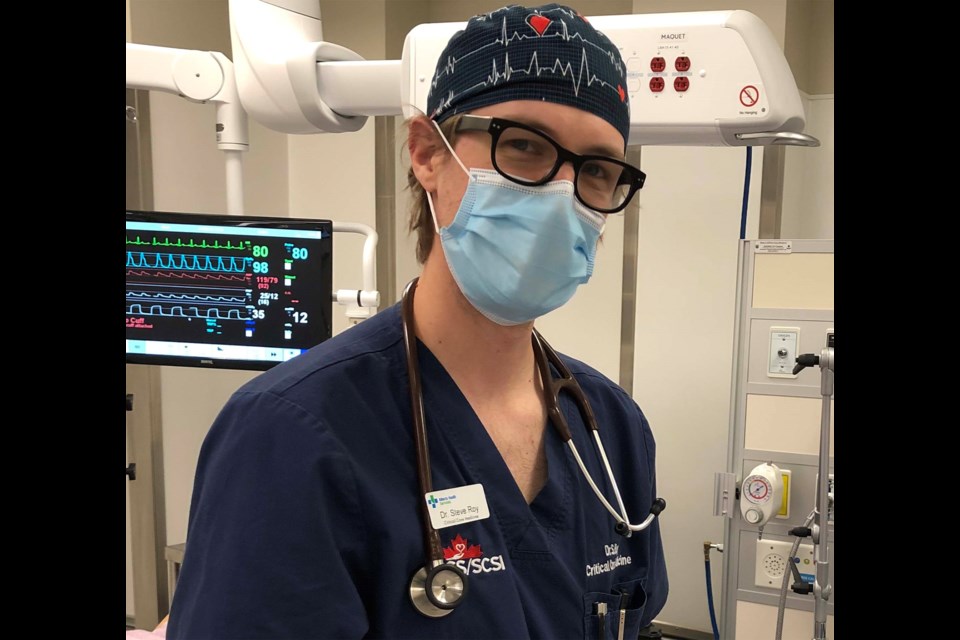The Valence InVent Xtend, a new medical device that does the work of four ventilators and at about 1/400th the cost of a single regular ventilator, has just received Health Canada approval.
This is just one chamber of the good news that landed on Dr. Steven Roy's desk over the last few weeks. The Paul Kane grad — now an ICU doctor in Calgary — explained that the pandemic precipitated the need for the device. The fact that the Alberta medical system is being stretched further than it ever has been before during the fourth wave of COVID-19 means this approval could not be more timely.
"It's just nice to know that, if it were needed, we'd be able to use it," a much relieved Roy explained.
Ventilators typically cost up to $70,000 each while the Valence InVent Xtend has a price tag of about $50 per patient. It works uniquely to allow each connected patient to have different ventilator pressures — what Roy calls "differential multi-ventilation" — despite sharing a single ventilator, while also avoiding the need for maintenance after prolonged storage.
Roy devised its design with inexpensive parts from a hardware store.
The approval came from an interim order Health Canada offered, which was part of an expedited process to accommodate approvals that would otherwise have been hindered due to the pandemic.
Expedited though it may have been, it sure was a long summer of waiting for Roy."I’m not sure how long the normal process is, but it still took more than six months."
He is now working to scale up production through Convergence Medical Sciences, the company he started to develop products and software to facilitate the work of front-liners and other colleagues in the health-care system. Production is another patience-tester, he offered, with the struggle to achieve enough funding to finance the workload. Creation of the final molds is quite expensive, Roy hinted, adding that an angel investor would be most welcome at this time.
In the best-case scenario, the Valence InVent Xtend could be available in four to six weeks.
"It's close enough that it could still be used within the pandemic, depending on what happens in Canada with mutations and stuff."
The interim order authorization provides Convergence with a two-year period to use the device in the setting of a crisis ventilator shortage. During this time, the company can convert the permission to a full, regular licence after an approved audit of its manufacturing process.
He struggled with the word "relief" to give a sense of how he feels at this point.
"I had confidence in our technology. It definitely feels good," he started. "In terms of timing, I'm glad that it wasn't any longer. I guess 'relief' is a pretty good word."
Kudos abound
Since he conceived the device during the first wave of the pandemic, this is the second major international design award granted. The first was the Red Dot Design Award, which also credited the pioneering design with its compact size, low weight, and clearly understandable pictogram instructions.
Now, the Valence InVent Xtend has an International Design Excellence Award (IDEA) on its shelf, too. Given out by the Industrial Designers Society of America, the IDEA "recognizes products and services that encourage, inspire, and push our industry forward," according to the society's website. Some of the world's most successful and popular products are IDEA winners, it adds, noting that exceptional design can make a product the vanguard for future winners.
"Winning the IDEA Award is a big deal for our company. It's quite a prestigious award to win," Roy said, noting that he now joins the ranks of past winners Apple and Tesla.
"I'm definitely honoured to be put into that kind of category."
There are gold, silver, and bronze levels of the award, though Roy wasn't allowed to specify which IDEA he won. The actual awards ceremony was scheduled for 4 p.m. EST on Sept. 21, past The Gazette’s deadline for the Sept. 22 edition. Results can be found on the organization’s website at www.idsa.org/idea-ceremony-2021.
At the same time, the device was up for the People's Choice Award, which received public voting. That will be announced during the Sept. 21 ceremony as well.
Regardless, his IDEA has earned the device's place in the permanent collection of the Henry Ford Museum.
Roy is now hard at work with some patents he expects to file soon. In his free time, the ICU doctor still works hard to treat people and ease the burden on health-care systems in this province and elsewhere."We have some other medical technology that I hope we can do some cool things with. But at the moment we're focused on [the fact that] the time is now for ventilator technologies, particularly for developing countries, and we're focused on bringing this to markets in places that will benefit from it and help reduce the burden on the health system, and hopefully save some lives."


